The bamboo poles stop just short of grazing the walls of the 17th century structure that, for 10 days, housed Pampa: Textiles of Karnataka — presented by the Abheraj Baldota Foundation, in collaboration with Karnataka’s department of tourism and the Archaeological Survey of India. A careful matrix of similar poles, held together sturdily with jute ropes, criss-cross the aged ceiling of the Mantapa Photo Exhibition Centre and hold the magnificent textiles.
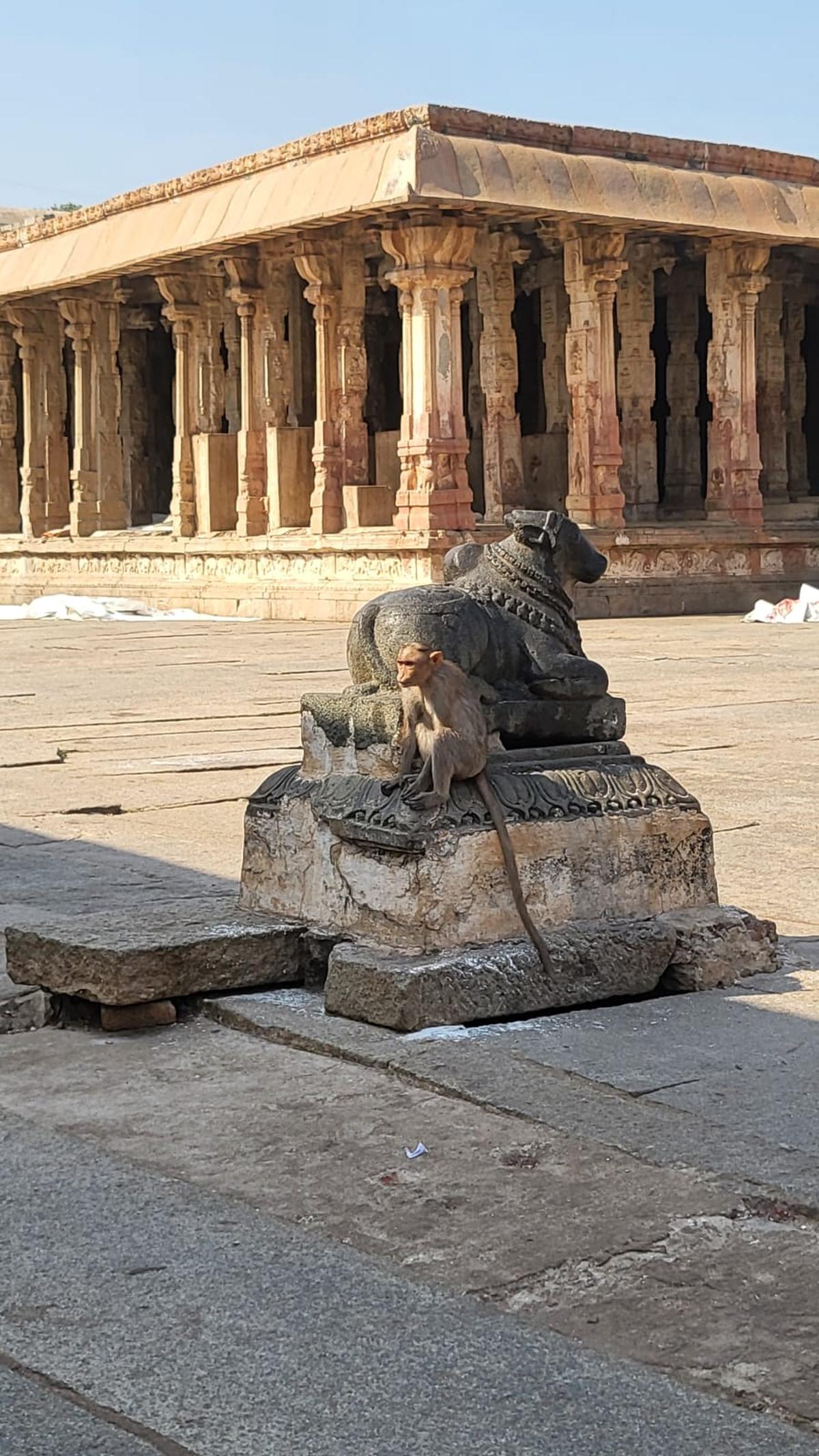
In Hampi, a UNESCO World Heritage Site
| Photo Credit:
Sumana Mukherjee
In a way, the exhibition design is an apt metaphor for the intent behind Pampa: one of building connections between the old and the new, each showing off the other to their best advantage to revive interest in the textiles of the state. “What we need is a synergy,” says Lavina Baldota, who made her curatorial presence felt as the patron of Sutr Santati: Then, Now, Next, a celebration of Indian textiles in 2022. Pampa is her sixth presentation, an ode to her marital home of Karnataka.
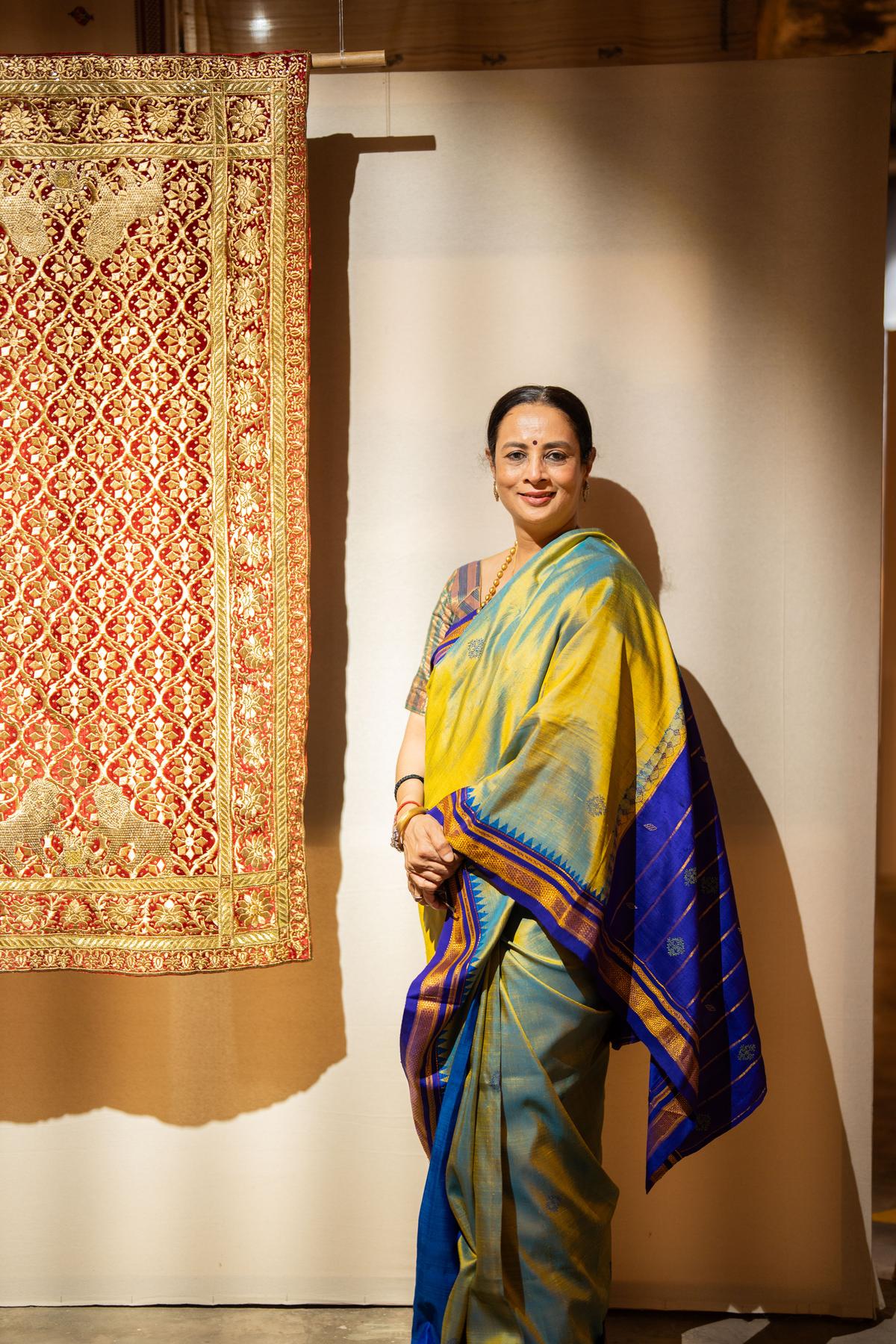
Lavina Baldota
| Photo Credit:
Courtesy of the Baldota Foundation
The state is not the first to be associated with a strong or storied textile legacy, especially when it comes to fine fabrics — in comparison to, say, Bengal or Gujarat or closer home, to Tamil Nadu — but Pampa (an ancient name for the mighty Tungabhadra), she hopes, will help it claim its rightful place in the sun. “As a survey exhibition, the first iteration of Pampa sets the framework for further work that the Baldota Foundation intends to take up in the region,” she adds. “The research will deepen, followed by documentation, revivals, and new commissions leading to exhibitions in other cities in Karnataka and beyond.”
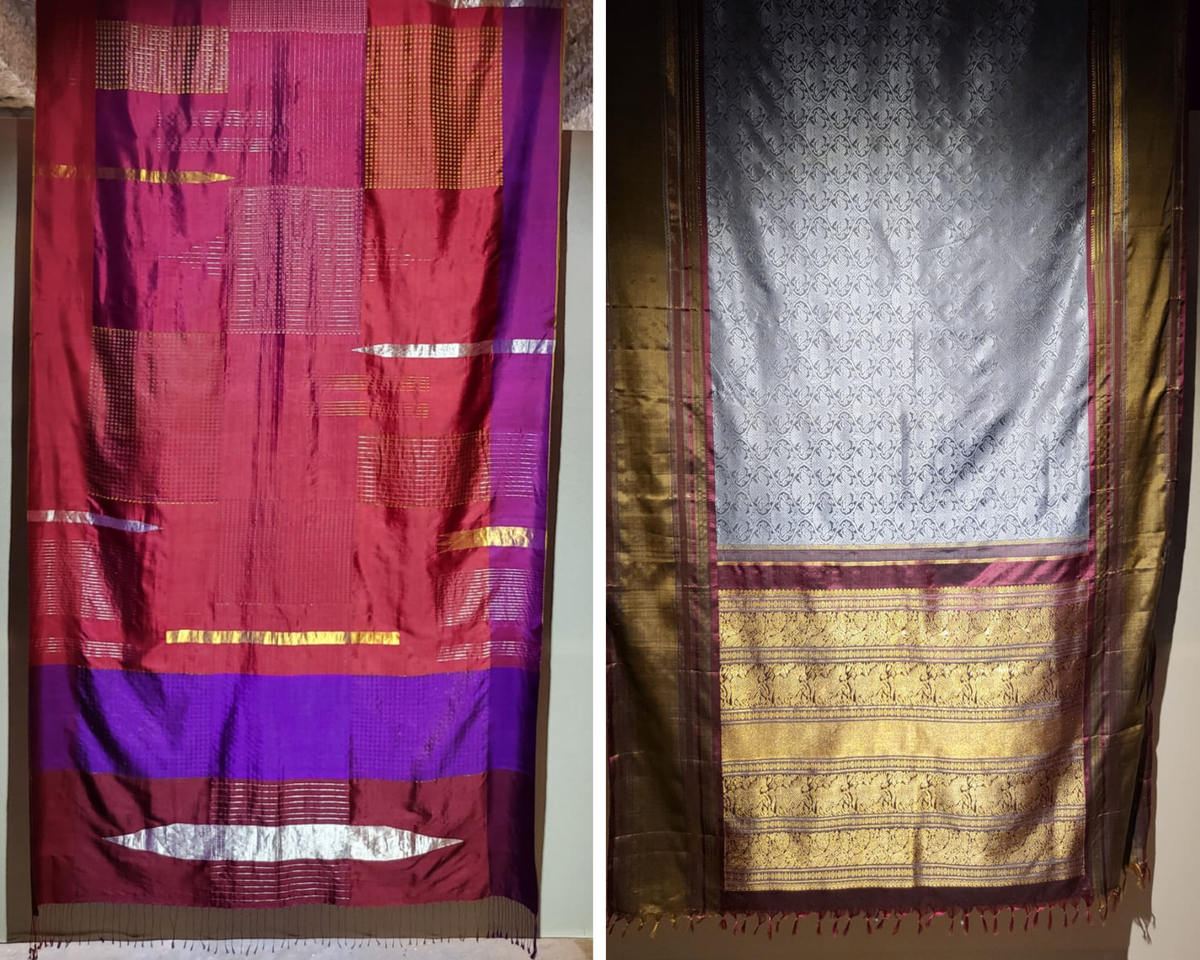
A couple of the saris on exhibit
| Photo Credit:
Sumana Mukherjee
Nayaka Kalamkari panel (cotton; handwoven, hand-drawn, resist-dyed using natural dyes) commissioned to Sriyasmita Mishra and Vipin Das of Chennai-based Aksh Studio
| Photo Credit:
Courtesy of the Baldota Foundation
Crafting an ecosystem
It’s a formidable ambition but there are few better placed than Baldota to realise it. As custodian of the 54-year-old Abheraj Baldota Foundation, an affiliate of the diversified Baldota Group, with businesses in mining, power, steel and similar core industrial areas, she is uniquely positioned to pull together discrete work on crafts and textiles — her core interest areas, building on an education in fashion and textiles — and provide them a powerful platform. Like the bamboo poles in the historical structure, Baldota enables weavers, designers, practitioners to get in touch with their desired audiences, including market-facing counterparts, so as to build a complete ecosystem.
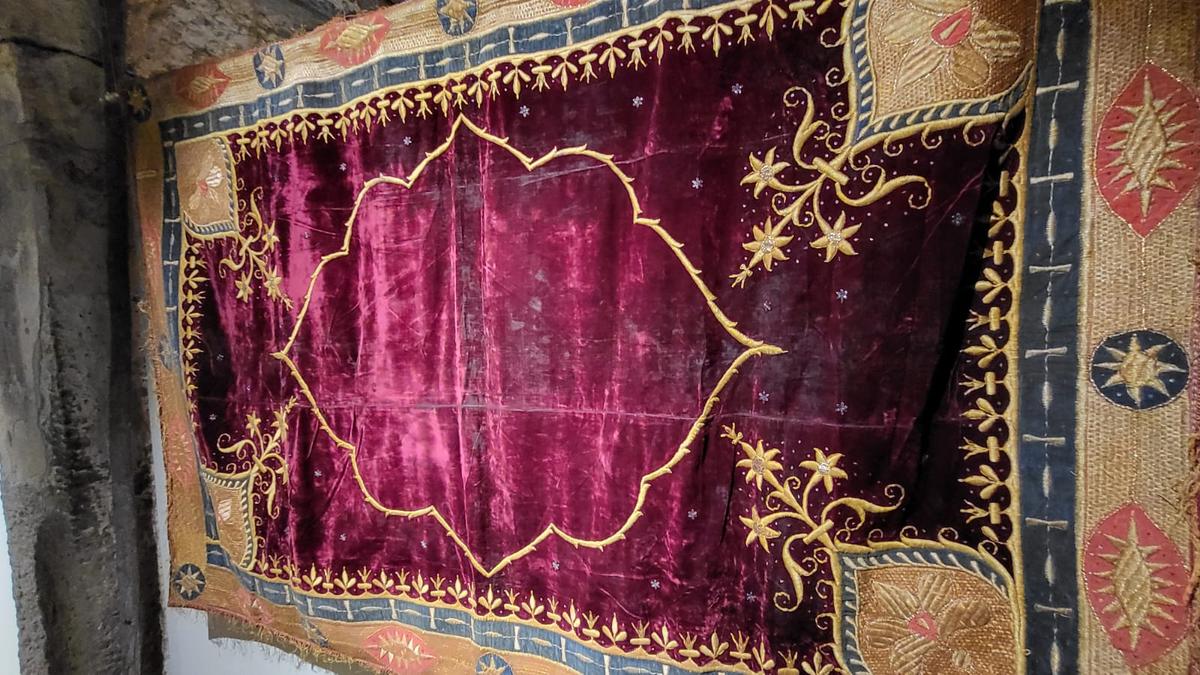
Close-up of an antique textile with zardosi, possibly created in the Deccan
| Photo Credit:
Sumana Mukherjee
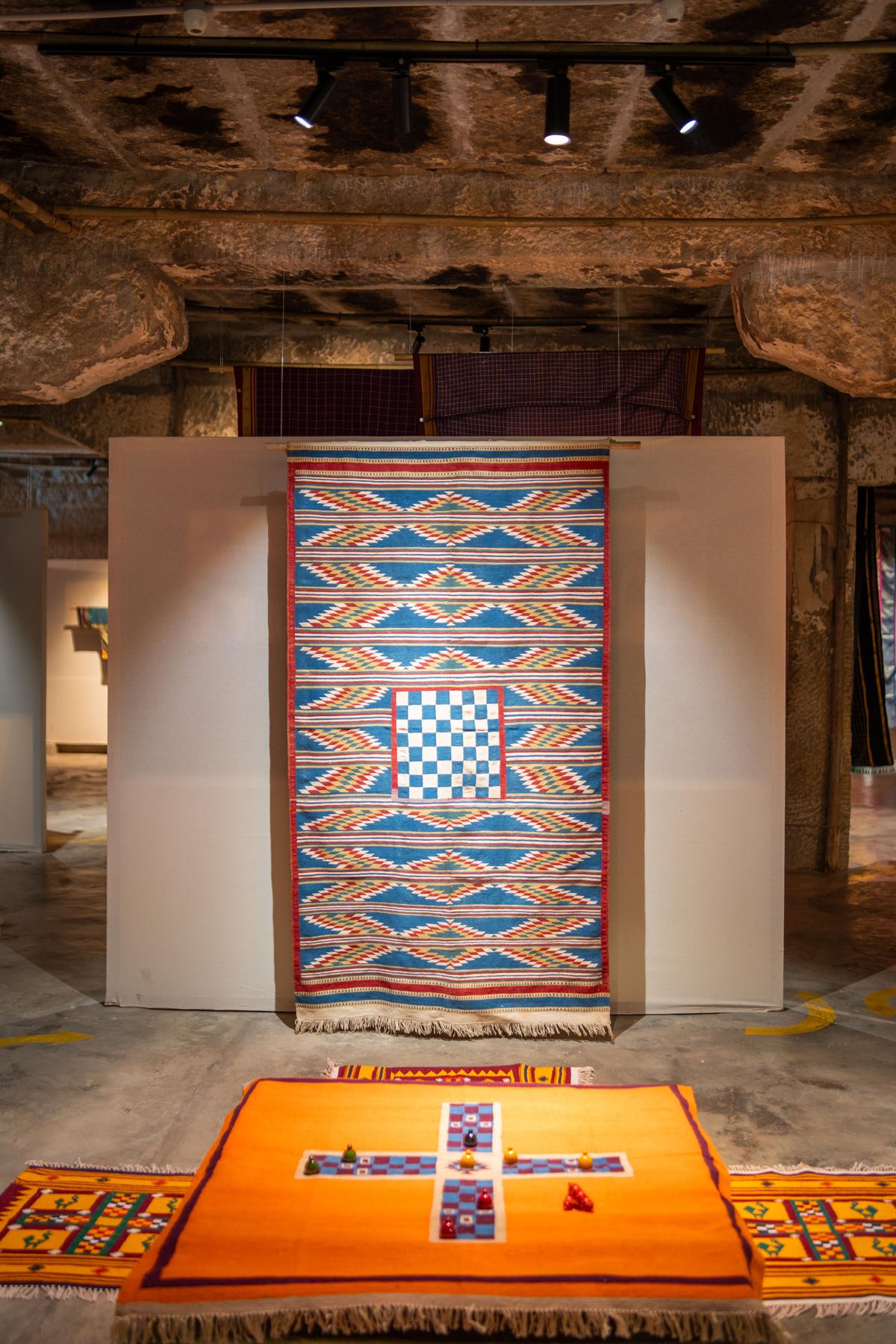
Installation of Navalgund durries
| Photo Credit:
Courtesy of the Baldota Foundation
In a way, it’s a conscious effort to update the finely balanced honeycomb of farmers, spinners, weavers, dyers, traders, transporters that existed in the pre-colonial heydays of handwoven Indian textiles. Today’s set-up still requires all of them, but it also needs champions who can take intellectual ownership, in a manner of speaking, of particular textile clusters to create documentation, disseminate information, forge connections, design for new generations and help build respectful markets.
That this is no isolated endeavour is evident from the fact that Pampa is the 20th textile exhibition Mayank Mansingh Kaul has curated in the past 10 years; it’s also his fourth for the Baldota Foundation. By any standards, that’s an impressive number, given the months of research each of them must have required. But it is as impressive as an indicator for the increased appetite for textile knowledge among the cognoscenti and the curious.
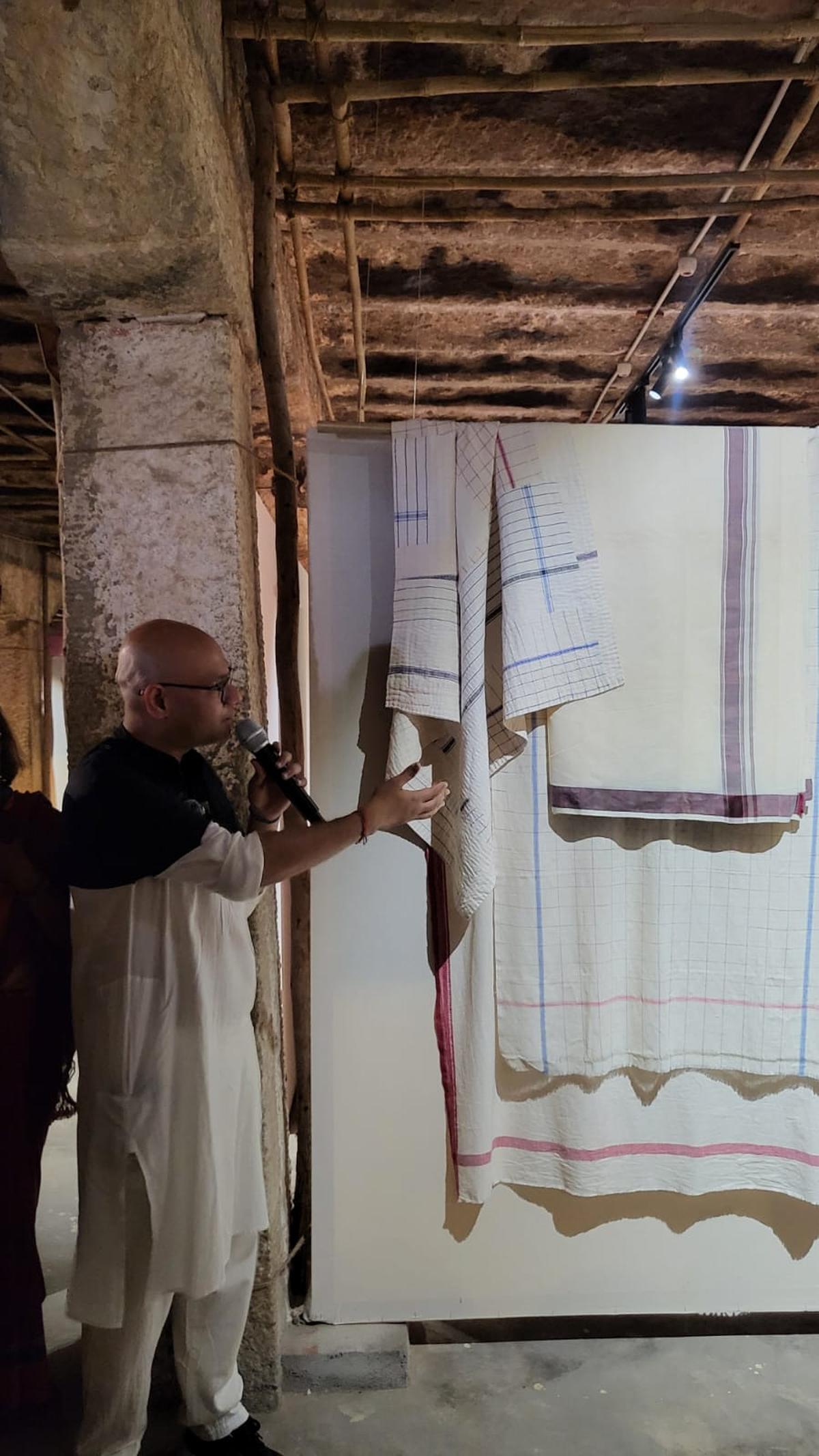
Mayank Mansingh Kaul speaking about the textiles on display
| Photo Credit:
Sumana Mukherjee

Installation view of the exhibition
| Photo Credit:
Courtesy of the Baldota Foundation
Saris and their stories
Featuring 108 textiles in nine sections, the exhibition (March 1-10) hits all the right notes, including an early Kalamkari recreation of the Shiva-Parvati wedding mural on the central ranga mantapa ceiling of the 7th century Virupaksha temple, and a display of the Tricolour in khadi, crafted in nearby Hubbali. The Karnataka Khadi Gramodyoga Samyukta Sangha is one of only five units authorised to make the national flag in its originally mandated weave. “When we set out on our research trips a few years ago, Lavina and I thought we’d find maybe 10 examples of handmade textiles,” says Kaul. “Instead, the further we travelled, the more we acquired.”
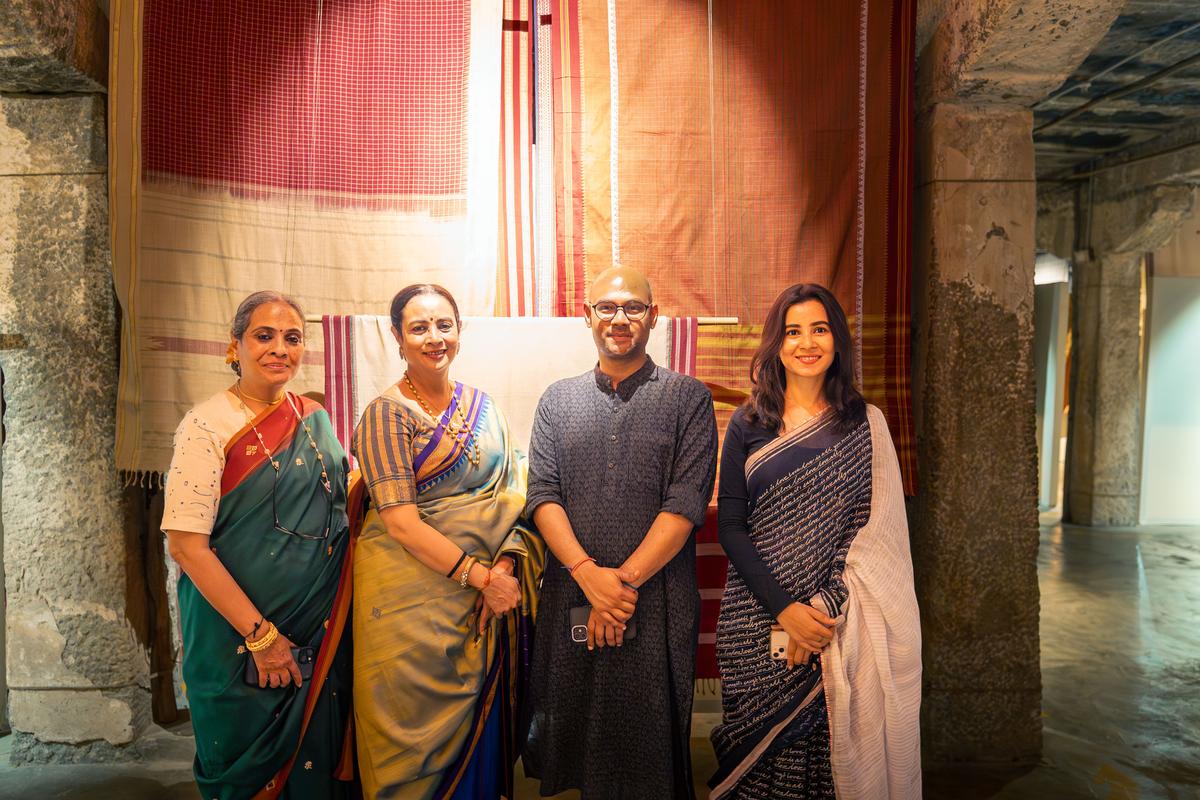
The curatorial team (L-R) Pragati Mathur, Lavina Baldota, Mayank Mansingh Kaul, and Nupur Saxena
| Photo Credit:
Courtesy of the Baldota Foundation
Deflecting often-justified criticism about the elite contents of textile exhibitions, Pampa makes it a point to showcase garments and home-linen of daily use: summer-friendly lungis, sheepwool kambli (blankets), bright Navalgud durries. There are also brilliant examples of vibrant Lambani embroidery and geometric kasuti work, both of which have found commercial success in many forms.
The Lambani enclosure, featuring the Day and Night Sky tent, showcases the intricate stitches of the Lambani tribe along with the dupatta, bangles, and lehenga-choli of Banjara women. It also includes a Kora Khadi
| Photo Credit:
Courtesy of the Baldota Foundation
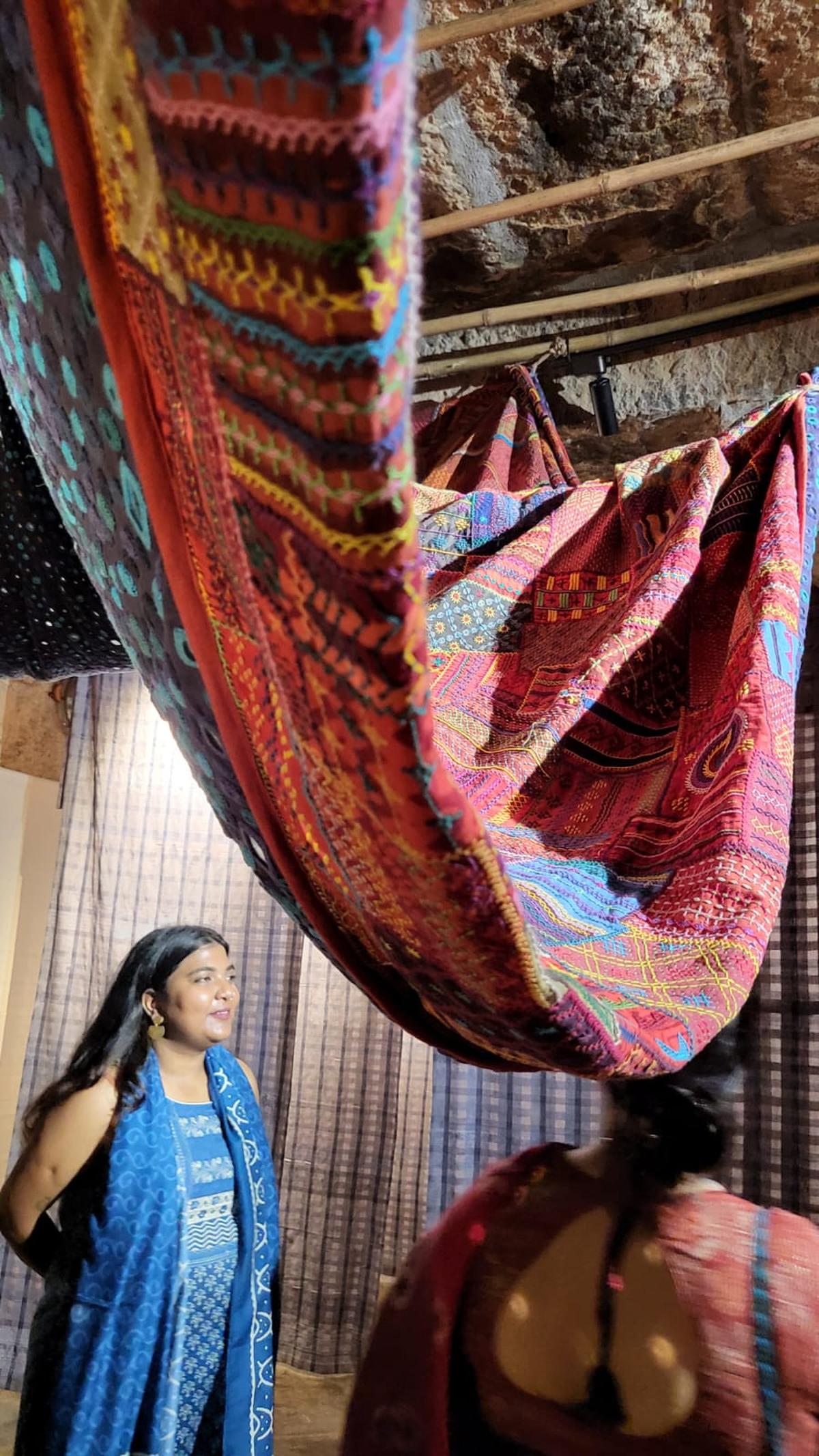
A close-up of the embroidery
| Photo Credit:
Sumana Mukherjee
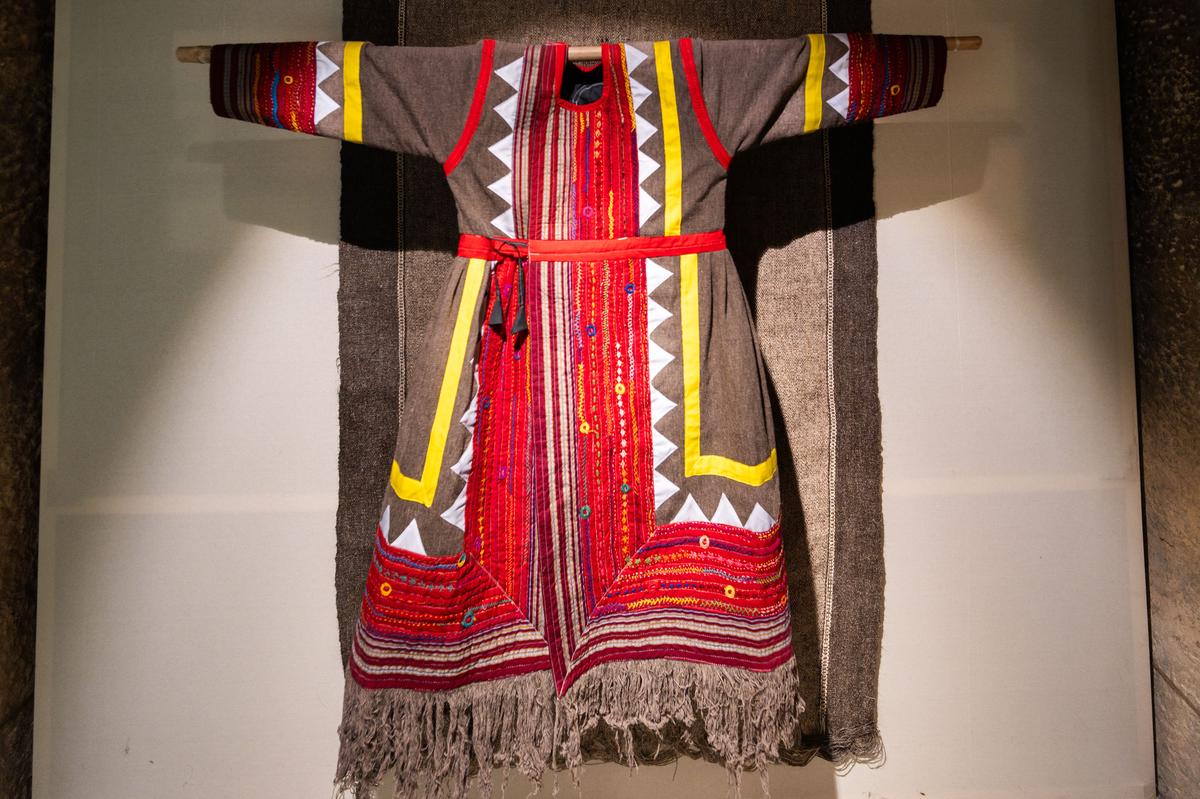
A traditional garment worn by pastoralists, acquired from the foundation Dakhnii Diaries
| Photo Credit:
Courtesy of the Baldota Foundation
Each of the textiles on display carries its own story, but perhaps none is more emotive than the ones woven into the warp and weft of saris. Historically, when artisans took to their looms, they found inspiration in the nature around them. Though much has changed over the centuries for Indian textiles, the hand-fans and turtles woven into the textured Kotpad handlooms of Odisha, for instance, still survive. Likewise, the ceremonial patteda anchus of Gajendragarh — originally made as an offering to local deity Yellamma — still use a joyous palette of mustards, maroons, greens and pinks and abjure inauspicious black.
Ilkals, with their distinctive tope-teni (loops-joined) pallus, pay homage to the jowar (sorghum) that grows all around the farming town; the design is inspired by the stalks of the crop, and the homegrown sari was also the agriculturists’ favourite drape. Multiple similar stories tumble out over the next few days: the vivid red palla of one is a tribute to menstrual blood, the woven border of another resembles chicken feet as an easy sell to a poultry-farming community, and many more.
Inspired by the temple carvings of the Vijayanagar dynasty and the drawings of Dr. Pierre-Sylvain Filliozat, these textile panels are block printed on handwoven silk-cotton fabric
| Photo Credit:
Courtesy of the Baldota Foundation
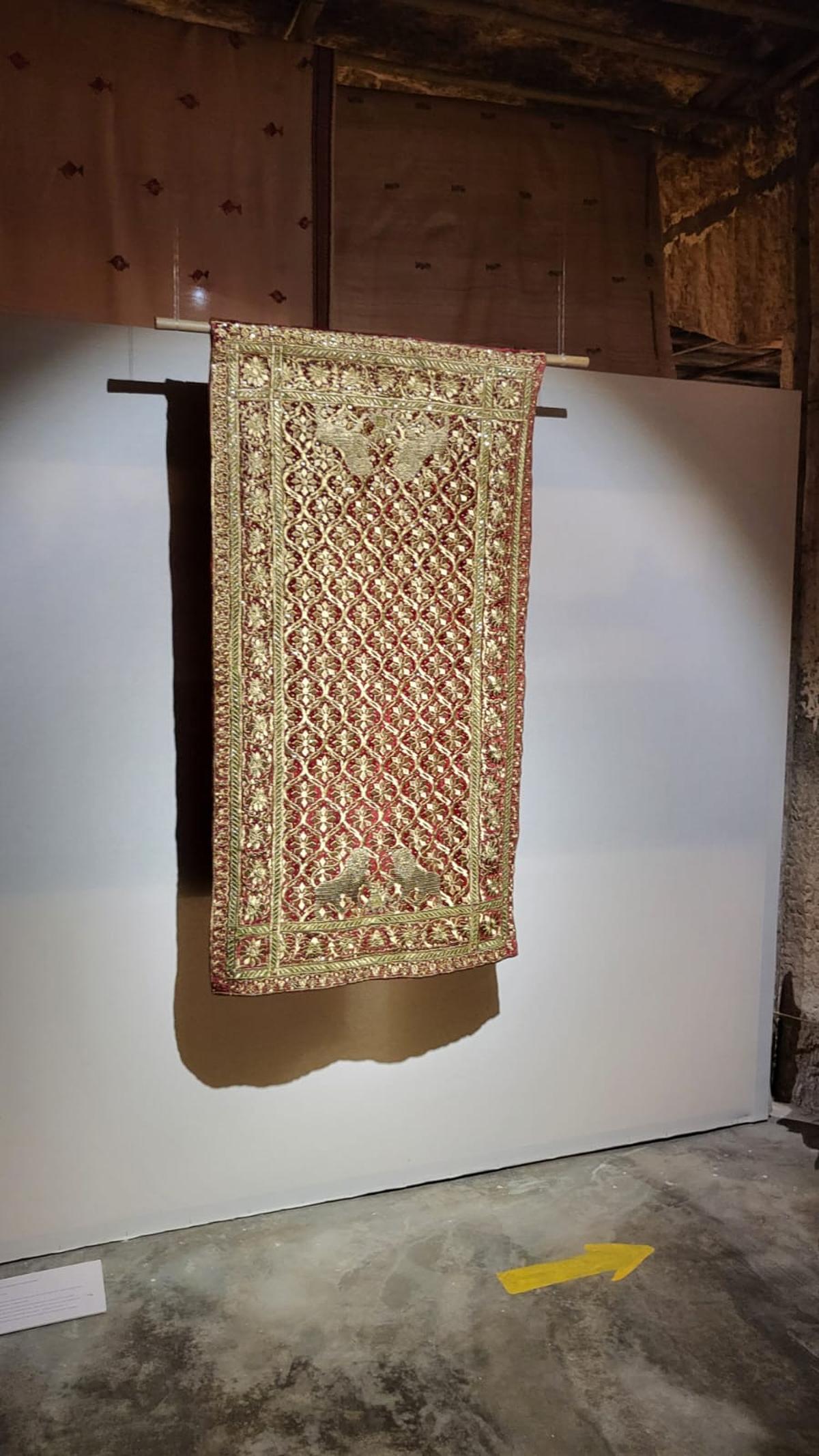
Metal thread on velvet zardozi, an opulent metal embroidery technique patronised in South India by Tipu Sultan
| Photo Credit:
Sumana Mukherjee
Born from the old
The most striking part of the exhibition, for this writer at least, is the juxtaposed collections of multiple practitioners. Some, like Pavithra Muddaya of Vimor, the textile brand from Bengaluru, would baulk at being called designers, despite their years of work in the field, but they have taken traditional weaves of the state and made them their own, while maintaining their traditional structures and motifs.
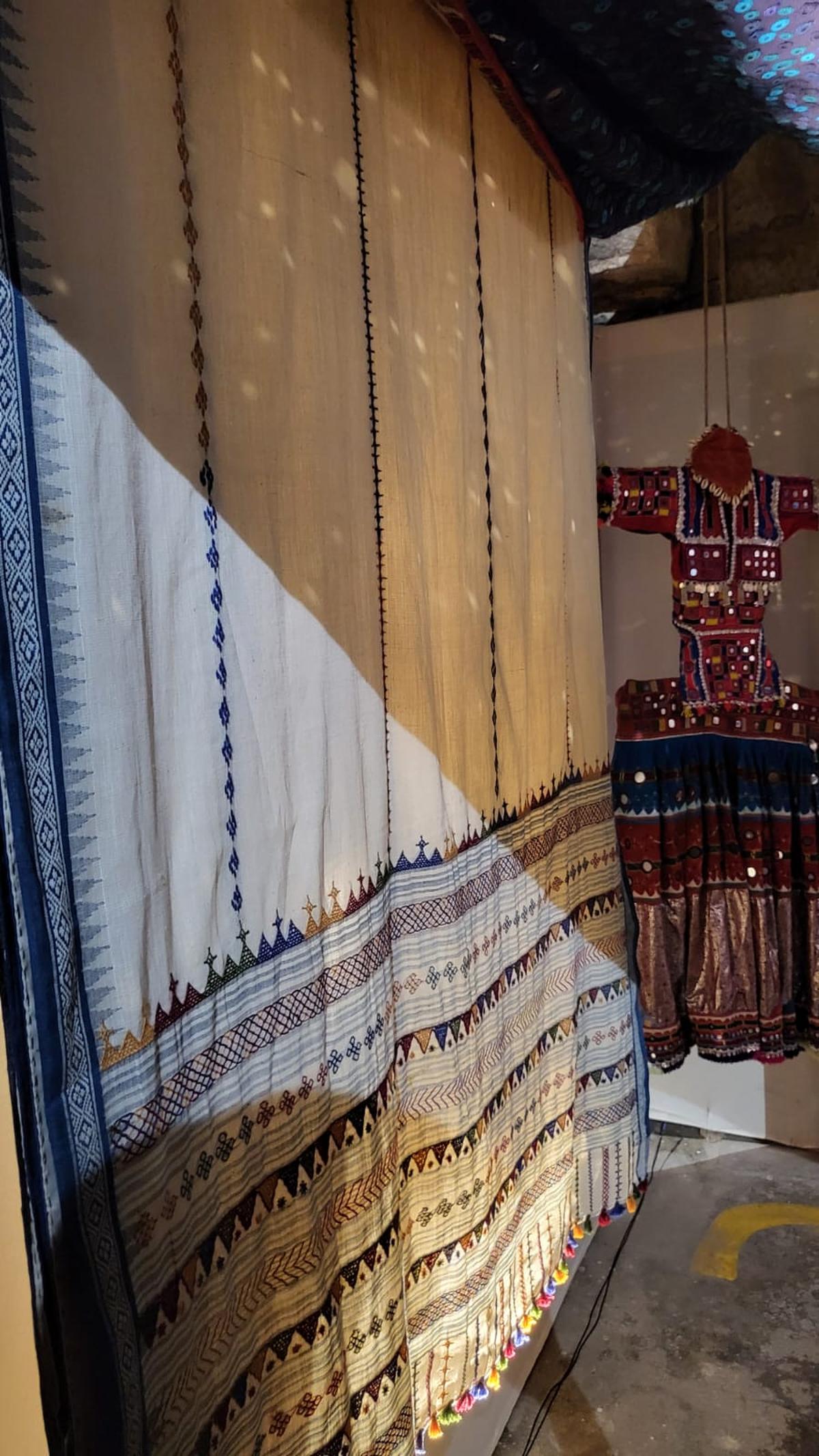
Kora Khadi sari with Lambani embroidery by Sandur Kushala Kala Kendra
| Photo Credit:
Sumana Mukherjee
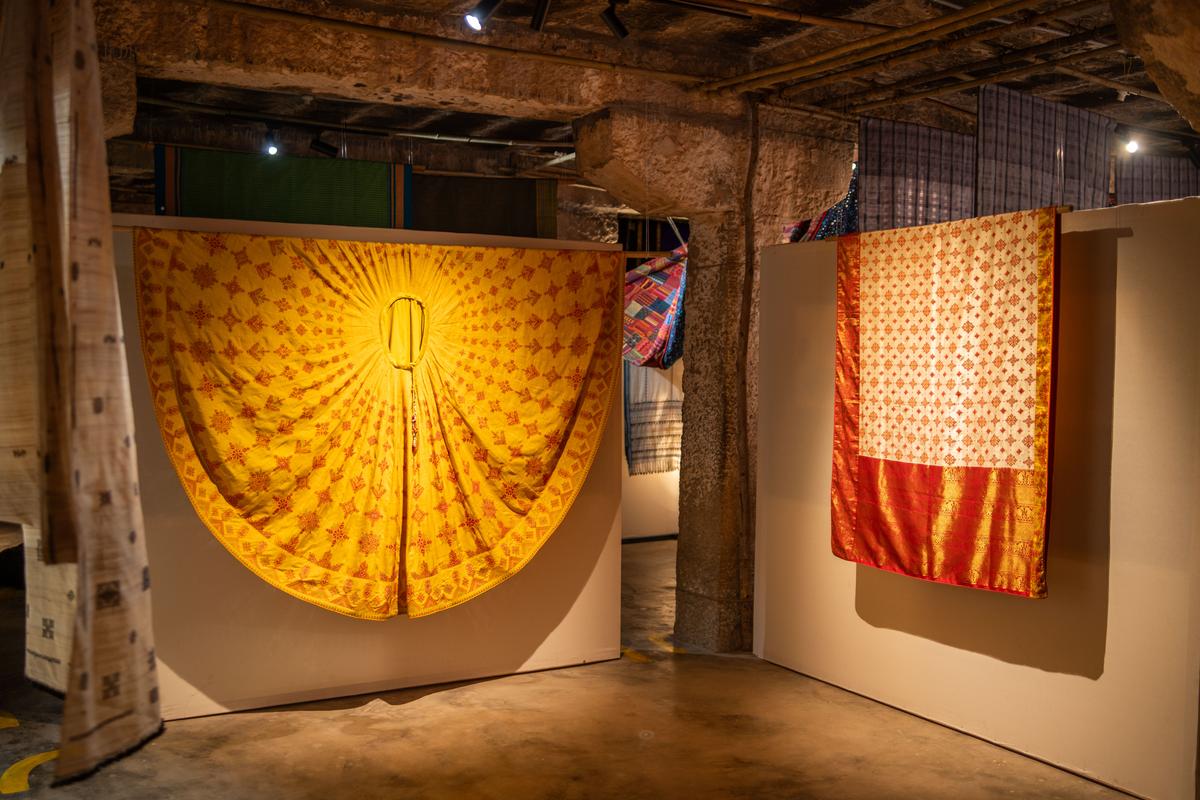
Silk ghagra and dupatta with Kasuti embroidery designed by Gaurang Shah
| Photo Credit:
Courtesy of the Baldota Foundation
Khann or khana, for example, is a narrow-width cloth of geometrical designs commonly used for tailoring blouses in neighbouring southern Maharashtra. But, in the hands of National Institute of Design graduate Geeta Patil, it finds fabulous expression in saris.
Equally marvellous is the square inch-by-square inch recreation of a 150-year-old Molakalmuru, the eponymous textile of a town in Karnataka’s Chitradurga district. In a state where the wealthy fell back on either Banaras or Kanchipuram for their occasionwear, Molakalmuru has long been known for saris brocaded in silk and metallic yarns. At Baldota’s direction, exhibition curators Pragati Mathur and Nupur Saxena sourced a magnificent blue-and-red silk from Bengaluru-based textile aficionado Uma Rao and convinced her to part with it temporarily. They then scoured Molakalmuru till they zeroed in on master weaver D.S. Manjunath.
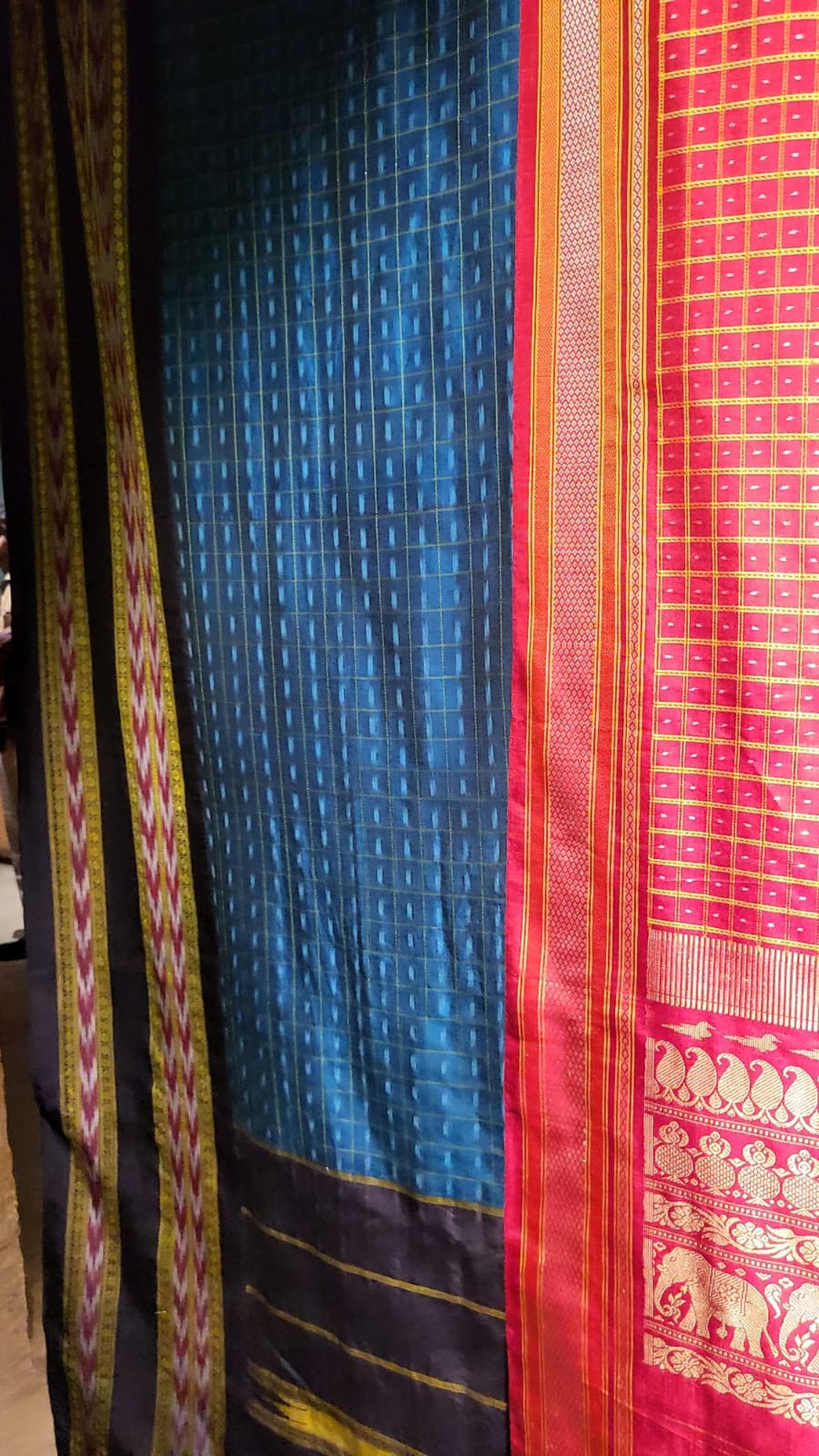
Close-up of the Molkalamoru saris
| Photo Credit:
Sumana Mukherjee
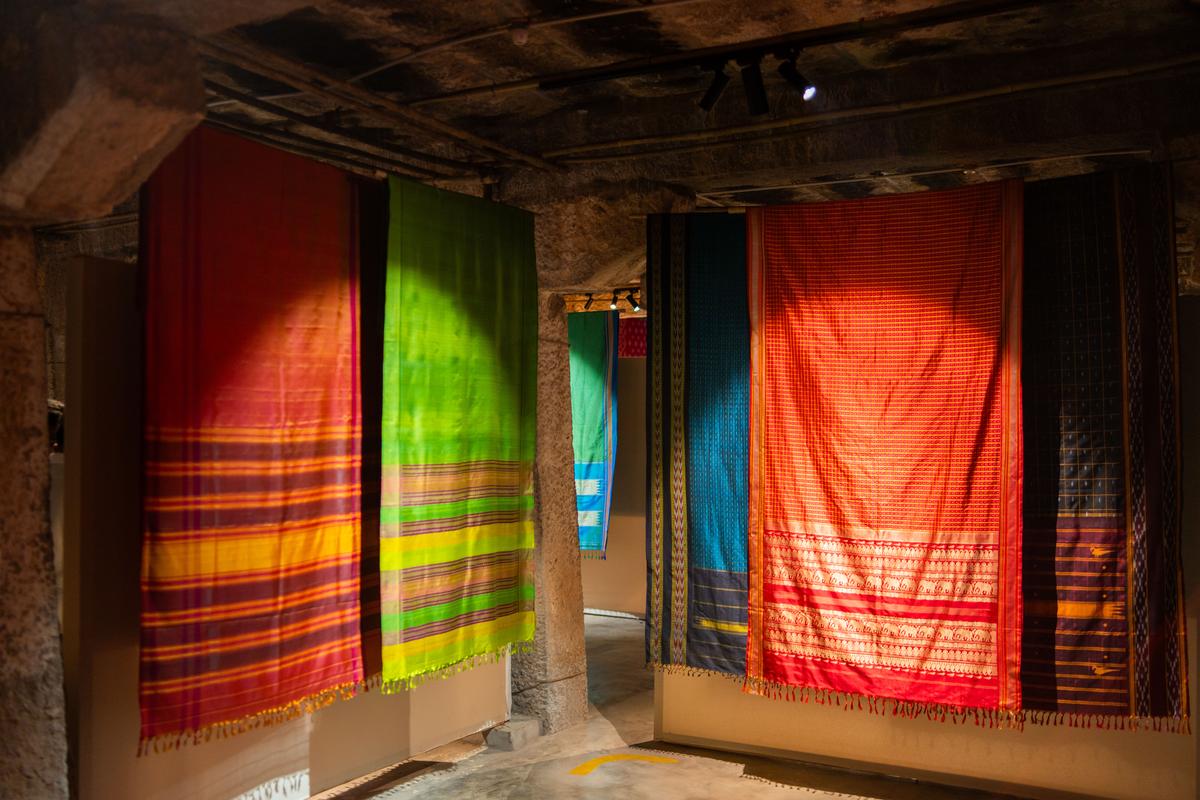
Installation of the Molkalamoru saris
| Photo Credit:
Courtesy of the Baldota Foundation
“Initially, I was very confident of being able to replicate the sari,” says Manjunath at the exhibition, as he introduces his work. “Then I turned it over, saw the underside and the incredible fineness of the work, and said it’s impossible.” With encouragement and time, though, Manjunath was successful in his efforts — and he even improved on it, by ensuring the double-parrot motifs at the intersection of the body and the palla were an evenly spaced dozen, instead of the 12-and-a-half as in the original.
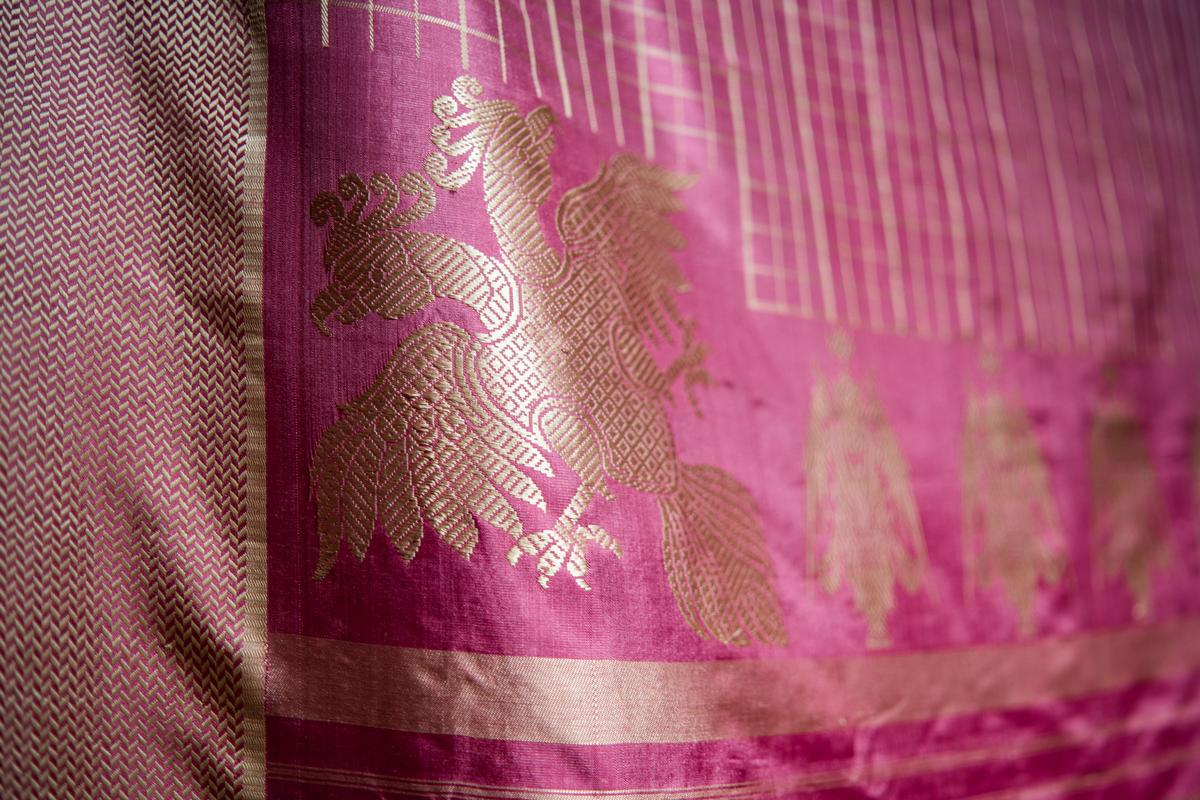
A revived Royal Mysore sari featuring the Ganda Berunda motif in silk on a lac-dyed silk body, woven on an Adai loom by Gayathri K.K.
| Photo Credit:
Courtesy of the Baldota Foundation
Perhaps one of the most rewarding takeaways of a well-curated exhibition is to witness its displays in a continuum. While there will undoubtedly be a domino effect, Pampa will probably be best served if it travels back to where it all began, to Ilkal and Navalgud and Molkalmuru and all the other clusters, bearing news of interest and investment to get the looms working with renewed vigour.
The writer is an editor and researcher based in Bengaluru.
Published – March 20, 2025 01:25 pm IST



